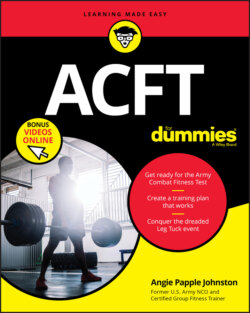Читать книгу ACFT For Dummies - Angela Papple Johnston - Страница 41
Hand Release Push-Up – Arm Extension
ОглавлениеThe Hand Release Push-Up – Arm Extension measures your upper body endurance. It represents repetitive and sustained pushing you may use during wartime operations, like shoving away a combatant, moving obstacles, or pushing a disabled vehicle. This one’s all about body weight, which you’re already equipped with when you show up on test day. Figure 2-4 shows which muscles you put to the test during this two-minute event.
© John Wiley & Sons, Inc.
FIGURE 2-4: Muscles used in the Hand Release Push-Up – Arm Extension.
This muscular endurance event requires plenty of front and back core strength. One push-up takes four separate movements, but you do them all smoothly without pause. You start from the ground, push yourself up, bend your elbows to lower your body to the ground, pick up your hands and make a T with your arms, and bring your arms back to the starting position. Then (finally), you’ve completed one repetition. Figure 2-5 shows the HRP from beginning to end.
Zack McCrory
FIGURE 2-5: The Hand Release Push-Up – Arm Extension.
The front leaning rest position is the only authorized rest position for the HRP. No more sagging in the middle or flexing your back! You can’t bend or flex your knees, hips, trunk, or neck, either.
The starting position for the HRP — where you are on the command of “Get set” — is the prone position on the ground. Your hands have to be flat, and your index fingers must be inside the outer edges of your shoulders (which makes it a lot like a tricep push-up). Your chest, hips, and thighs have to be flat on the ground, and your toes have to be on the ground with your ankles flexed. Your feet can be together or up to the grader’s boot’s width apart. Your head doesn’t have to be on the ground, but if you’re wiped out from the Standing Power Throw, I’m definitely not one to judge.
You can adjust your feet during the event, but you can’t lift them off the ground to do it.
These are the four movements for the HRP:
Movement 1: On the command of “Go,” push your body up from the ground as a single unit by fully extending your elbows. If you don’t maintain a generally straight body alignment from your head to your ankles, your reps don’t count. You end this movement in the front leaning rest.
Movement 2: From the front leaning rest position, bend your elbows to lower your body back to the ground. Your chest, hips, and thighs should touch the ground at the same time. You don’t have to touch your face or head to the ground.
Movement 3: Move both arms out to the side, straightening your elbows until you’re in the T position. After you extend your arms completely, bring your hands back beneath your shoulders. This is an immediate movement.
Movement 4: Place your hands flat on the ground with your index fingers inside the outer edges of your shoulders, returning to position to execute movement 1 again. When your hands are back under your shoulders, you’ve completed one repetition.
If you rest on the ground, pick up your feet, fail to keep a straight body alignment, or fail to continuously move, your grader will terminate the event. The repetitions you have completed (remember, a rep isn’t done until your hands are back under your shoulders) still count.
You need 10 HRPs to score 60 points, 20 for 65 points, and 30 for 70 points. If you can knock out 60, you score 100 points.
